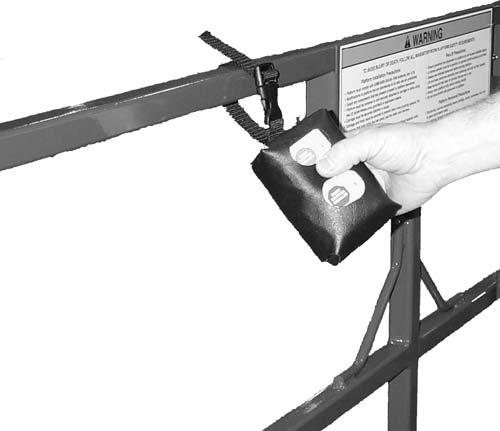
26 minute read
3 Check Lists . . . . . . . . . . . . . . . . . . . . . . . . . . . . . . . . . . . . . . . . . . . . . . . . .6
from Manitou MT6642XT MT8044XT MT10044XT MT10055XT MT12042XT Telescopic Handler Operator Manual - PDF
Chapter 3
CHECKLISTS
PRE-DELIVERY
The following Checklist is an important reminder of the inspections that MUST be made before delivering the Telescopic Handler to the customer. Check off each item after the prescribed action is taken. √ Check that:
q NO parts of machine have been damaged in shipment.
Check for such things as dents and loose or missing parts; correct or replace components as required. q Battery is securely mounted and not cracked. Cable connections are tight. Electrolyte at proper level. q Cylinders, hoses and fittings are not damaged, leaking or loosely secured. q Oil, fuel and air filters are not damaged, leaking or loosely secured. q All grease fittings have been properly lubricated and no fittings are missing; see Lubrication chapter of this manual. q Wheel nuts are torqued to 450 ft.-lbs. (610 Nm). q Tires are inflated to: 13.00 x 24 - 12 PR: 65 psi (450 kPa) cold. 14.00 x 24 - 12 PR: 62 psi (430 kPa) cold. q Hydraulic system reservoir, engine crankcase, engine coolant, transmission and axles are filled to the proper operating fluid levels. q All adjustments have been made to comply with the settings in this manual and in the separate engine manual. q All guards, shields and decals are in place and securely attached. q Model and serial number for this unit is recorded in space provided on this page and page 1.
Start the machine and test-run the unit while checking that proper operation is exhibited by all controls.
√ Check that:
q All indicators (lamps, switches, etc.) function properly. q All hand and foot controls operate properly. q The PWP System operates properly (if equipped). Refer to
Service and Storage chapter for procedure to check the
PWP System. q Boom, Quick-attach System with attachment tool and frame level control all function properly. q No hydraulic system leaks when under pressure. q Listen for abnormal noises or vibrations; if detected, determine their cause and repair as necessary. I acknowledge that the pre-delivery procedures were performed on this unit as outlined above.
Dealership’s Name
Dealer Representative’s Name
Date Checklist Filled Out
Machine Model No. Machine Serial No. Engine Serial No.
DELIVERY
√ Check that:
The following Checklist is a reminder of the important information that MUST be passed on to the customer at the time the unit is delivered. Check off each item as it is explained to the customer. q Review with the customer the contents of this manual and the AEM Safety Manual and for the following: q The Index at the back, for quickly locating topics; q The Safety, Indicators and Controls, and Operation and
Adjustments chaptersfor information regarding safe use of the machine. q The Lubrication and Service and Storage chapters for information regarding proper maintenance of the machine.
Explain that regular lubrication and maintenance are required for continued safe operation and long life. q Give this Operator’s Manual and the AEM Safety Manual to the customer and instruct them to be sure to read and completely understand their contents before operating the unit. q Remind the customer of U.S. OSHA regulation 1910.178 (l), which specifies operator training requirements. q Explain that the customer MUST consult the engine manual (provided) for related specifications, operating adjustments and maintenance instructions. q Completely fill out the Owner’s Registration, including customer’s signature, and return it to the Company. q Explain that a copy of the warranty is included on the inside back cover of this Operator’s Manual.
Customer’s Signature
Date Delivered
(Dealer’s File Copy - Remove at Perforation)
(To be removed as Dealer’s file copy)
Chapter 4 SAFETY
The above Safety Alert Symbol means ATTENTION!
ALWAYS BE ALERT! YOUR SAFETY IS
INVOLVED! It stresses an attitude of “safety awareness” and can be found throughout this Operator’s Manual and on the machine itself.
Before operating this equipment, read and study the following safety information. In addition, be sure that everyone who operates or works with this equipment is familiar with these safety precautions.
DANGER
Manitou Americas ALWAYS takes the operator’s safety into consideration when designing its machinery, and guards exposed moving parts for his/her protection. However, some areas cannot be guarded in order to assure proper operation. Further, this Operator’s Manual, AEM Safety Manual and decals on the machine warn of additional hazards, and should be read and observed closely. REMEMBER! It is the owner’s responsibility for communicating information on the safe use and proper maintenance of this machine! This includes providing understandable interpretations of these instructions for operators who are not fluent in reading English. It is the responsibility of the operator to read and understand the Operator’s Manual and other information provided and use the correct operating procedure. Machines should be operated only by qualified operators.
“DANGER” indicates an imminently hazardous situation, which, if not avoided, will result in death or serious injury. MANDATORY SAFETY SHUTDOWN
PROCEDURE
WARNING
“WARNING” indicates a potentially hazardous situation, which, if not avoided, could result in death or serious injury.
CAUTION
“CAUTION” indicates a potentially hazardous situation, which, if not avoided, may result in minor or moderate injury. It may also alert to unsafe practices. BEFORE cleaning, adjusting, lubricating or servicing the unit: 1.Stop machine on a level surface. (Avoid parking on a slope, but if necessary, park across the slope and block the tires.) 2.Fully retract the boom and lower the attachment tool to the ground. Idle engine for gradual cooling. 3.Place controls in neutral and apply parking brake.
4.Shut off the engine and remove the key. ONLY when you have taken these precautions can you be sure it is safe to proceed. Failure to follow the above procedure could lead to death or serious bodily injury.
SAFETY
WARNING
U.S. OSHA regulations require employers in general industry and the construction, shipyard and cargo-handling industries (excepting agricultural operations) to ensure that forklift operators are competent, as demonstrated by successful completion of a training course. The training course must consist of a combination of formal instruction and practical training, including both forklift-related and workplace-related topics, and evaluation of the operator’s performance in the workplace. All operator training and evaluation is to be conducted by persons who have the knowledge, training and experience to train and evaluate operators.
WARNING
ALWAYS maintain a safe distance from electric power lines and avoid contact with any electrically charged conductor or gas line. It is not necessary to make direct contact with a power line for power to ground through the structure of the machine. Keep the boom and load at least 10 ft. (3 m) from all power lines. Accidental contact or rupture can result in electrocution or an explosion. Contact the “Call Before You Dig” referral system number at 8-1-1 in the U.S., or 888-258-0808 in the U.S. and Canada, to locate any underground utility lines BEFORE starting to dig. Additional Safety Reminders
Ü User/operator safety practices, as established by industry standards, are included in this Operator’s
Manual and intended to promote safe operation of the machine. These guidelines do not, of course, preclude the use of good judgment, care and common sense as may be indicated by the particular jobsite work conditions. Ü It is essential that operators be physically and mentally fit, free of mind altering drugs and chemicals and thoroughly trained in the safe operation of the machine. Such training should be presented completely to all new operators and not condensed for those claiming previous experience. Information on operator training is available from several sources, including the manufacturer. Ü Some illustrations used in this manual may show doors, guards and shields open or removed for illustration purposes ONLY. BE SURE that all doors, guards and shields are in their proper operating positions BEFORE starting the engine.
Before Operation Safety Reminders
Ü Perform a pre-start walk-around inspection before starting the engine at the beginning of each work shift. Contact with a running engine or moving parts during the pre-start inspection could cause death or serious injury. Refer to the pre-start walk-around inspection checklist in the
“Operation and Adjustment” chapter. Ü Walk around the machine and warn all personnel who may be servicing the machine or who are in the machine path prior to starting. DO NOT start until all personnel are clearly away from the machine.
Ü Check brakes, steering, and hydraulic system prior to starting operation. Operate all controls to ensure proper operation. Observe all gauges and indicators for proper operation. If any malfunctions are found, correct the cause prior to using the machine.
SAFETY
Ü ALWAYS wear appropriate personal protective equipment for the job and working conditions.
Hard hats, goggles, protective shoes, gloves, reflector-type vests, respirators and ear protection are exampes of types of equipment that may be required. DO NOT wear loose fitting clothing, long hair, jewelry or loose personal items while operating or servicing the machine. Ü ALWAYS check the job site for terrain hazards, obstructions and people. Remove all objects that do not belong in or on the machine and its equipment.
Operation Safety Reminders
Ü Any or all of the following elements may affect the stability of the machine: terrain, engine speed, type of load being carried and placed, improper tire inflation, weight of the attachment tool, and abrupt movement of any control lever. IF YOU
ARE NOT CAREFUL WHILE OPERATING
THIS MACHINE, ANY OF THE ABOVE
FACTORS COULD CAUSE THE MACHINE
TO TIP AND THROW YOU OUT OF THE
OPERATOR’S STATION, WHICH MAY
CAUSE SERIOUS BODILY INJURY OR
DEATH!
Ü ALWAYS wear the seat belt provided to prevent being thrown from the machine. If you are in an overturn:
- DO NOT jump! - Hold on tight and stay with the machine! - Lean away from the fall! Ü ALWAYS keep hands, feet and arms inside of the operator’s station when operating the machine! Ü ALWAYS use the recommended hand holds and steps with at least three points of support when getting on and off the machine. Keep steps and platform clean. Face the machine when climbing up and down. Ü DO NOT depend on the backup alarm to clear bystanders out of the path of the machine.
ALWAYS look in the direction of travel. Look to
the rear before backing. Ü DO NOT raise or drop a loaded fork or bucket suddenly. Abrupt movements under load can cause serious instability. Ü Study the load chart carefully. It shows maximum capacity to be lifted and placed at specific outward and upward distances. ALWAYS be aware of load weights prior to attempting lift and placement with this machine.
Ü DO NOT exceed the machine’s rated operating capacity for the type of attachment tool being used.
Ü DO NOT use outriggers on soft or uneven surfaces. BE SURE the surface can support the machine and load. Ü DO NOT allow minors or any unqualified personnel to operate or be near the machine unless properly supervised. Ü DO NOT start the engine or operate any controls unless properly seated in the operator’s seat! Ü DO NOT run the engine in an enclosed area without providing proper ventilation for the exhaust.
Exhaust gases contain carbon monoxide, an odorless and deadly gas. Internal combustion engines deplete the oxygen supply within enclosed spaces and may create a serious hazard unless the oxygen is replaced. This includes the atmosphere within the cab when equipped. Ü DO NOT leave the operator’s station with the boom and attachment tool raised. ALWAYS lower the boom and attachment tool to the ground, shut off the engine and engage the parking brake before leaving the operator’s station. Ü NEVER travel with the boom above the carry position (attachment tool should be at minimum ground clearance.) Boom should be fully retracted.
Ü DO NOT drive too close to an excavation or ditch. BE SURE that the surrounding ground has adequate strength to support the weight of the machine and the load it is carrying.
SAFETY
Ü DO NOT turn quickly while traveling on a slope or operate the machine beyond the grade and slope limits noted in the Operation and
Adjustments chapter of the Operator’s Manual. Ü NEVER allow any riders on this machine. This is strictly a single-seat, NO-passenger machine Ü NEVER use as a lift for personnel unless the machine is equipped with the Personnel Work
Platform (PWP) System. Ü When road travel is required, know and use the signaling devices on the machine. Provide an escort and Slow-Moving Vehicle (SMV) emblem when required. Ü If necessary to park on a slope, park across the slope and block the tires.
Suspended Load Safety Reminders
The handling of suspended loads by means of a truss boom, winch, boom mounted lift hook or other similar device can introduce dynamic forces affecting the stability of the machine that are not considered in the stability criteria of industry test standards. Grades and sudden starts, stops and turns can cause the load to swing and create a hazard. Refer to the following guidelines for handling suspended loads.
WARNING
U.S. OSHA regulations effective November 8, 2010 (29 CFR Part 1926, Subpart CC - Cranes and Derricks in Construction) include requirements for employers that use powered industrial trucks ("forklifts") configured to hoist (by means of a winch or hook) and move suspended loads horizontally. In particular, this regulation applies to any rough-terrain forklift (e.g., "telescopic handler") equipped with a jib or truss boom with a hook (with or without a winch), or a hook assembly attached to the forks. [Note: This regulation is in addition to the OSHA regulation that requires specific forklift operator training: §1910.178(l).] When a forklift / telescopic handler is configured and used for hoisting, the employer must ensure that: 1.Forklift, lift equipment and rigging have been inspected (each shift, month and year) and are in good, safe condition and properly installed. 2.An operator's manual and applicable load charts are on the forklift.
3.Work zone ground conditions can support the equipment and load. Any hazardous conditions in the work area have been identified, and the operator notified. 4.Equipment is being used within its rated capacity and in accordance with the manufacturer's instructions. 5.Operator and crew members have been trained in the safe use and operation of the equipment, including how to avoid electrocution. 6.During use, no part of the equipment, load line or load will be within the minimum clearance distance specified by OSHA [10 feet (3.0 m), and more for lines rated over 50 kV] of any energized power line, and any taglines used are non-conductive. 7.In addition, for lift equipment with a rated capacity greater than 2000 lbs. (907 kg), the employer must ensure that: a.)An accessible fire extinguisher is on the forklift; b.)Monthly and annual inspections are performed and documented, and records retained (three months for monthly, one year for annual); c.)Before November 10, 2014, operators must have had the additional training and qualification / certification required by OSHA regulations §1926.1427 and §1926.1430.
SAFETY
Note: Refer to the full text of the OSHA crane regulation (29 CFR Part 1926, Subpart CC) for a detailed description of the regulatory requirements.
Ü DO NOT exceed the rated capacity of the telescopic handler as equipped for handling suspended loads. The weight of the rigging must be included as part of the load. Ü During transport, the length of the rigging between the attachment and load should be as short as possible to reduce booms height and movement. DO NOT raise the load more than 12 inches (305 mm) above the ground, or raise the boom more than 45 degrees. Ü Only lift the load vertically – NEVER drag it horizontally. Ü Use multiple pickup points on the load when possible. Use taglines to restrain the load from swinging and rotating. Ü Start, travel, turn and stop SLOWLY to prevent the load from swinging. DO NOT exceed walking speed. Ü Inspect rigging before use. Rigging must be in good condition and in the U.S. comply with
OSHA regulation §1910.184, “Slings,” or §1926.251, “Rigging equipment for material handling.” Ü Rigging equipment attached to the forks must be secured such that it cannot move either sideways or fore and aft. The load center must not exceed 24 inches (610 mm). Ü DO NOT lift the load with anyone on the load, rigging or lift equipment, and NEVER lift the load over personnel. Ü Beware of the wind, which can cause suspended loads to swing, even with taglines. Ü DO NOT attempt to use frame-leveling to compensate for load swing.
Servicing Safety Reminders
Ü ALWAYS be aware of and avoid pinch point areas on the machine, such as wheels-to-frame, cylinders-to-frame, boom and attachment tool-toframe.
Ü NEVER attempt to by-pass the keyswitch to start the engine. ONLY use the jump-starting procedure detailed in the Service and Storage chapter. Ü NEVER use your hands to search for hydraulic fluid leaks. Use a piece of paper or cardboard.
Escaping fluid under pressure can be invisible and can penetrate the skin, causing serious injury. If any fluid is injected into your skin, see a doctor at once. Injected fluid MUST be surgically removed by a doctor familiar with this type of injury or gangrene may result. Ü ALWAYS wear safety glasses with side shields when striking metal against metal. In addition, it is recommended that a softer (chip-resistant) material be used to cushion the blow. Failure to heed could lead to serious injury to the eyes or other parts of the body. Ü DO NOT refill the fuel tank when the engine is hot. Allow engine to cool down before refilling to prevent hot engine parts from igniting the fuel if it should spill or splash. Ü DO NOT smoke while filling the fuel tank, working on the fuel or hydraulic systems, or working around the battery. Ü DO NOT fill the fuel tank completely. Allow room for expansion. Maintain control of the fuel filler nozzle when filling the tank. Use the correct fuel grade for the operating season. Ü Static electricity can produce dangerous sparks at the fuel-filling nozzle. Do not wear polyester, or polyester-blend clothing while fueling. Before fueling, touch the metal surface of the machine away from the fuel fill to dissipate any built-up static electricity. Do not re-enter the machine but stay near the fuel filling point during refueling to minimize the build-up of static electricity. Do not use cell phones while fueling. Make sure the stat-
SAFETY
ic line is connected from the machine to the fuel truck before fueling begins. Ü Ultra-Low Sulfur Diesel (ULSD) poses a greater static ignition hazard than earlier diesel formulations. Avoid death or serious injury from fire or explosion; consult with your fuel or fuel system supplier to ensure the entire fuel delivery system is in compliance with fueling standards for proper grounding and bonding practices. Ü NEVER use fuel for cleaning purposes. Ü DO NOT remove the radiator cap after the engine has reached operating temperature or if it is overheated. At operating temperatures, the engine coolant will be extremely HOT and under pressure. ALWAYS wait for the engine to cool before attempting to relieve pressure and remove the radiator cap. Failure to heed this warning could result in severe burns.
Ü DO NOT loosen or disconnect any hydraulic lines, hoses or fittings without first relieving hydraulic circuit pressure. Also, be careful not to touch any hydraulic components that have been in recent operation because they can be extremely hot and can burn you! Ü Avoid lubrication or mechanical adjustments with the machine in motion or the engine running. If the engine must be running to make certain adjustments, place the transmission in neutral, apply the parking brake, place the equipment in a safe position, securely block the tires and use extreme caution.
Ü To ensure continued safe operation, replace damaged or worn-out parts with genuine Manitou service parts before using this equipment.
Ü Modifications and additions that affect capacity or safe operation must never be performed without the manufacturer’s prior written approval.
Where such authorization is granted, any applicable markings are to be changed accordingly. Ü All attachment tools MUST be marked to identify the attachment tool and the total capacity with the attachment tool at maximum elevation with the load laterally centered. Ü ALWAYS be sure all nameplates, warnings and instruction markings are in place and legible.
Local government regulations may require specific decals, which are the responsibility of the owner to provide.
Safety Guards and Warning Devices
Ü This machine is fitted with a Roll-Over Protective
Structure (ROPS) and Falling Object Protective
Structure (FOPS) in accordance with industry standards. It is intended to offer protection to the operator from falling objects and in case of an overturn, but it cannot protect against every possible hazard. Therefore it should not be considered a substitute for good judgment and safe practices in operating the machine. If the ROPS /
FOPS structure is damaged, it must be replaced to restore the protection it provides. Ü This machine is equipped with a horn and backup alarm. The user must determine if operating conditions require the machine to be equipped with additional devices (mirrors, rotating beacon, etc.) and be responsible for providing and maintaining such devices.
Personnel Work Platform (PWP) System
WARNING
The machine must not be used to lift or carry personnel, or be fitted with any form of personnel work platform unless fitted with the optional PWP System. If fitted with the PWP System, the Mandatory Work Platform Safety Rules must be followed at all times while lifting personnel.
SAFETY
The Mandatory Work Platform Safety Rules must be adhered to at all times while elevating personnel. These rules are based on ANSI/ITSDF Standard B56.6-2005, “Safety Standard for Rough Terrain Forklift Trucks.” (A copy of this and related standards can be obtained from the Industrial Truck Standards Development Foundation, 1750 K Street NW, Suite 460, Washington, DC 20009; or downloaded from: www.itsdf.org.) The rules apply to the owner, operator and the personnel in the work platform.
MANDATORY WORK PLATFORM SAFETY RULES
1.The work platform must comply with
ANSI/ITSDF B56.6-2005, Sec. 8.24, “Platforms for Elevating Personnel.” (See page 16, “Work
Platform Design Requirements.”) 2.The platform must be securely attached to the carriage or forks, and the carriage securely attached to the boom. The forks must not protrude beyond the floor of the work platform. 3.The carriage and forks must be secured to prevent them from pivoting upward. 4.If the machine is equipped with a rotating or swinging carriage, the rotation or swing must be deactivated. (This occurs automatically when the
PWP System is switched on.) 5.Personnel on the platform must be provided protection from any moving parts on the forklift that may present a hazard. 6.If overhead hazards exist for platform personnel, overhead protection must be provided. 7.Be sure that the lifting mechanism is operating smoothly throughout its entire range, both empty and loaded, and that any lift-limiting devices and latches are functional.
8.Be sure that the frame is level, to ensure a vertical lift.
9.Be sure the platform is horizontal before lifting. 10.Be sure that the forklift has a firm footing. 11.Be sure that any required restraining means (railings, chains, harnesses, etc.) are in place and properly used. 12.Before lifting personnel, shift the transmission into Neutral, apply the parking brake, and activate the PWP System mode switch. 13.Before lifting personnel, the area should be marked to warn others of work by elevated personnel.
14.Be sure the path of platform travel is clear of hazards, such as scaffolds, electrical wires and overhead obstructions.
15.The operator must keep hands and feet clear of controls that are not in use.
16.Personnel must be lifted and lowered smoothly and cautiously, and only at their request. 17.The platform must be lowered fully before moving the forklift. Do not drive the forklift with personnel on the platform. 18.Elevated personnel must always be alerted before raising or lowering the platform. 19.A trained operator must be in position to operate the forklift and boom controls at all times.
20.The combined weight of the platform, personnel and load must not exceed one-third of the material-handling capacity of the forklift. 21.Platform personnel must maintain firm footing on the platform floor. A harness is to be worn and a lanyard attached to the platform or boom when working from an elevated work platform, in accordance with OSHA regulations. Use of railings, planks, ladders, etc. on platform for the purpose of achieving additional reach or height is prohibited. 22.Workers on the platform must keep all parts of their bodies inside the work platform during raising and lowering. 23.Be sure that the personnel and equipment on the platform do not exceed the available space.
SAFETY
24.The platform must be fully lowered for personnel to enter and exit. Personnel must not climb on any part of the forklift in attempting to enter and exit.
25.Any harness, body belt, lanyard, or deceleration device that has sustained permanent deformation or is otherwise damaged must be replaced. 26.Modifications to the platform that are detrimental to its safe use are prohibited.
WARNING
Use ONLY an approved work platform for elevating personnel. NEVER move the machine with the work platform in a raised position or with personnel on board.
NEVER tilt the platform forward, rearward, or to the side with personnel on board. ALWAYS engage the PWP System and follow the Mandatory Work Platform Safety Rules when elevating personnel.
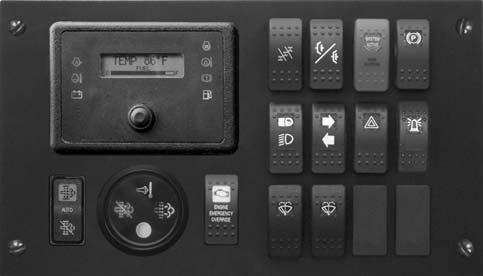
Work Platform Switch Electrical Connection
PWP Remote Shutdown Switch

Remote Shutdown Switch with Coiled Wire Connector
PWP Remote Shutdown Switch
Wireless Remote Shutdown Switch on MT10055
Wireless Remote Battery Replacement
1.Remove the four screws from the cover of the wireless remote.
2.Open the cover to gain access to the batteries. 3.Remove the batteries from their holders.
4.Install the replacement batteries in the holder taking care to position the battery terminals as shown in the diagram at the bottom of the battery holder. 5.Replace the cover and install the screws to secure the cover in place.
Work Platform Design Requirements
(Per ANSI/ITSDF B56.6-2005, Sec. 8.24) 1.A platform floor having a slip-resistant surface located not more than 8 inches (200 mm) above the normal load-supporting surface of the forks.
SAFETY
2.Floor dimensions, which shall not exceed two times the load center distance of 24 inches (610 mm) listed on the forklift nameplate, measured parallel to the longitudinal center plane of the forklift, nor have a width greater than the overall width of the forklift (measured across the loadbearing tires) plus 10 inches (250 mm) on either side. Minimum space for each person on the platform shall not be less than 18 inches (450 mm) in either direction.
3.A 4 inch (100 mm) minimum height toe plate, which may be omitted at the access opening. 4.An overhead protective device, when requested by the user. 5.Protection for personnel in their normal working position on the platform from moving parts of the forklift that may present a hazard. 6.Information prominently indicated on the platform:
a.maximum work load including personnel and equipment, b.weight of empty platform. 7.Means so that the platform can only be centered laterally on the forklift, and retained against the vertical face of the forks, carriage or lifting machanism.
8.A means to securely attach the platform to the lifting mechanism, and to prevent the platform from inadvertantly pivoting. 9.Restraining means such as a guardrail or a means for securing personnel such as a body harness and lanyard. A guardrail or similar structure shall have a nominal height to the platform floor of 42 inches (1066 mm) around its upper periphery and include a midrail. It may be hinged, removable, or of chains, and used to provide an access opening, if proper positioning is easily accomplished and a secure condition is discernable. Such restraining means shall be capable of withstanding a concentrated horizontal force of 200 lb. (890 N) applied at the point of least resistance without permanent deformation. A body harness and lanyard is to have an attachment point provided overhead for freedom of movement, and its length is to limit free-fall to 5 feet (1500 mm) measured from the point of attachment to the operator. The complete system shall be capable of withstanding three consecutive drop tests to simulate a 250 lb. (113 kg) person falling 6 feet (1800 mm) without allowing the test weight to fall free to the ground.
A deceleration device may be included. NOTE: Fall protection should comply with applicable U.S. OSHA regulations: 1910.67 (c)(2)(v) (for General Industry) or 1926.453 (b)(2)(v) (for Construction).
10.Lanyards, when provided, shall be arranged so as not to cause a tripping hazard. 11.Body harnesses, when provided, should have a width of at least 1.75 inches (44 mm). 12.Structural safety factor - all load-supporting structural elements of the work platform shall have a structural safety factor of not less than 2-to-1 based on the minimum yield strength of the materials used.
SAFETY

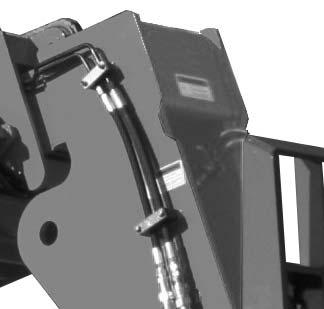
808037
808033 808031
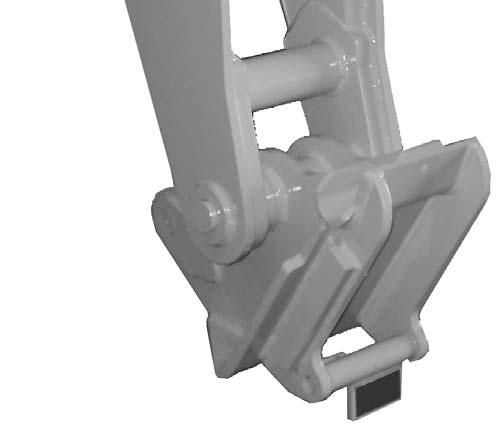
808027 808026

808029
808030
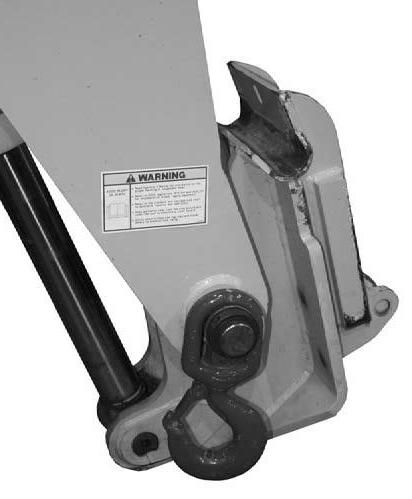
808033 808038
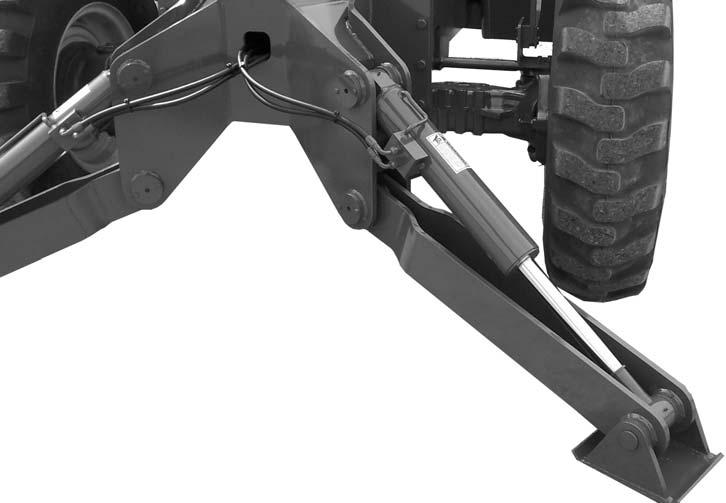
50380987
SAFETY
808031
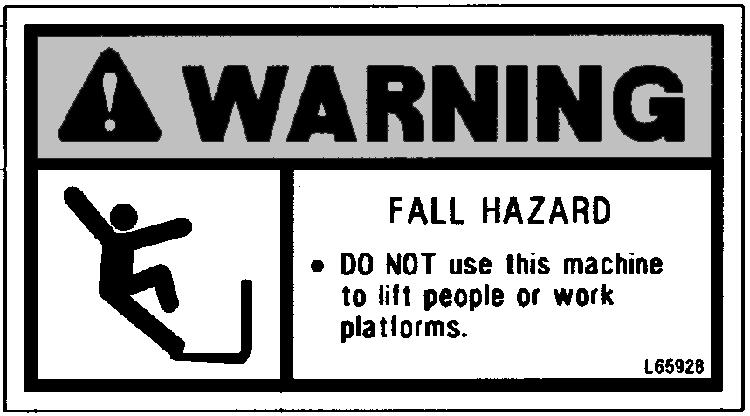
808037
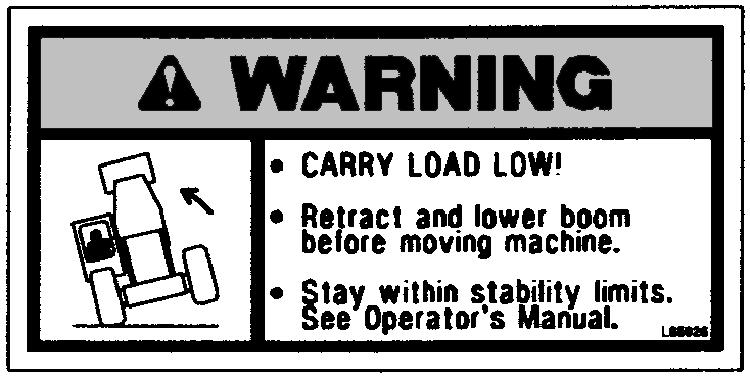
808033
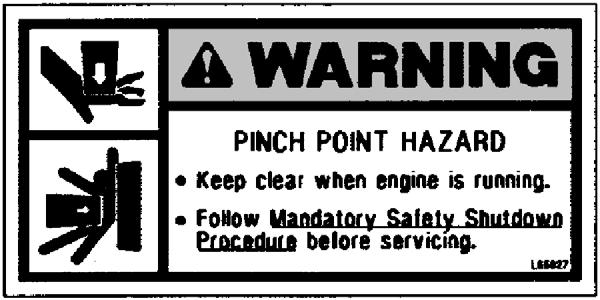
50380987 808038
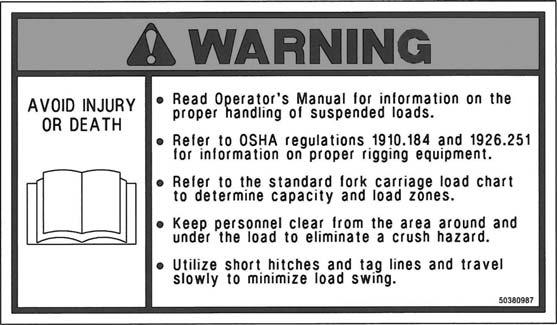
RED
808030 808029 808027
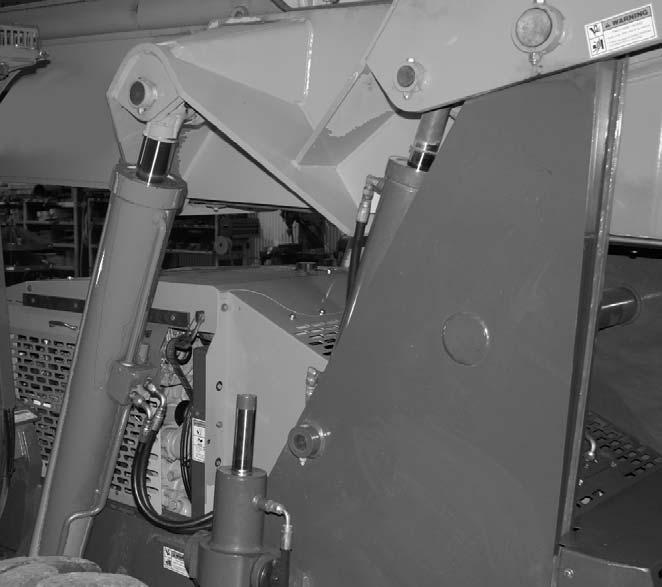
808033
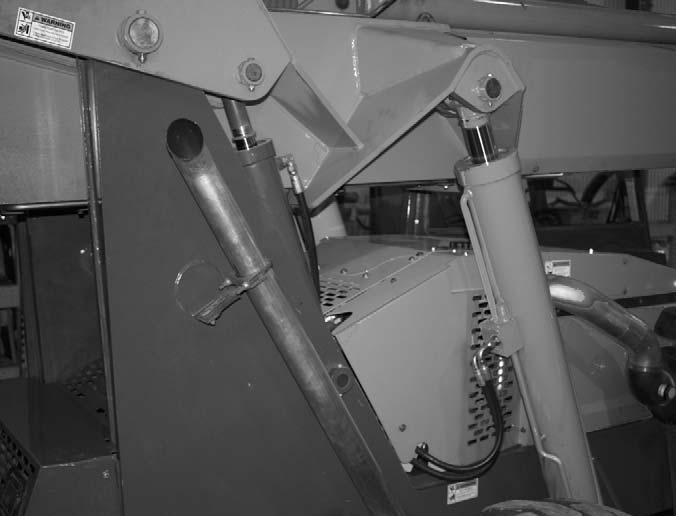
SAFETY
51200535
808034
808036
808033
808033
808032 808031
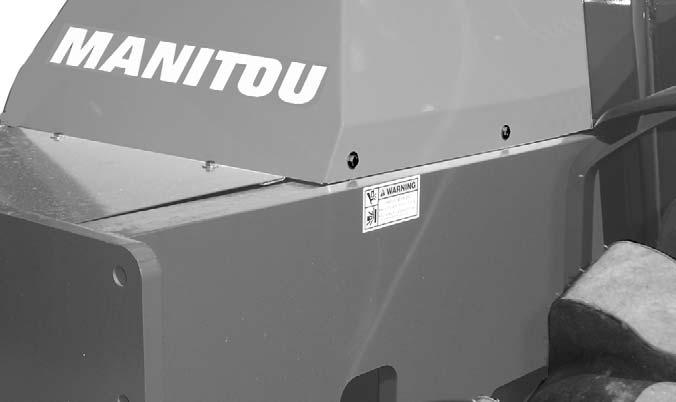
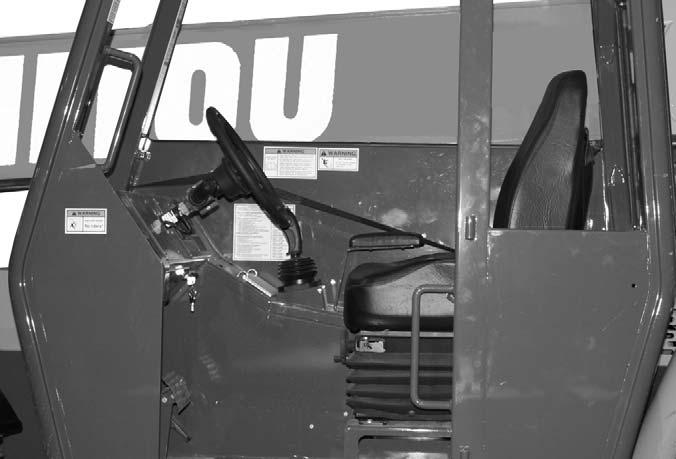
808035 808033
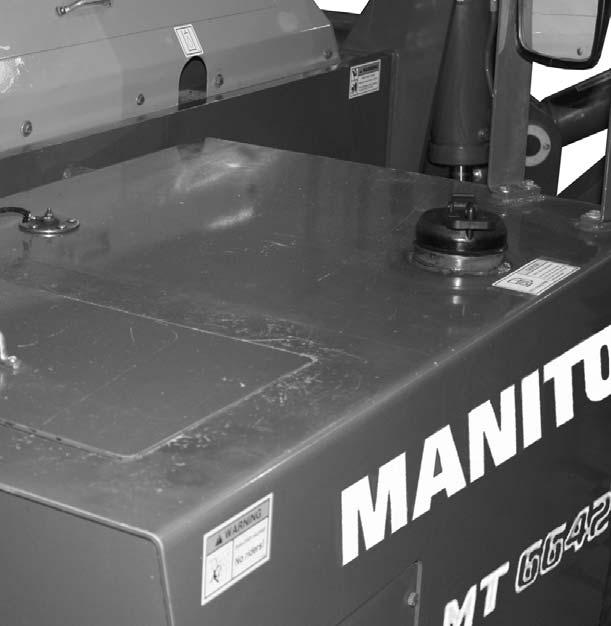
808035
SAFETY
808031

808032
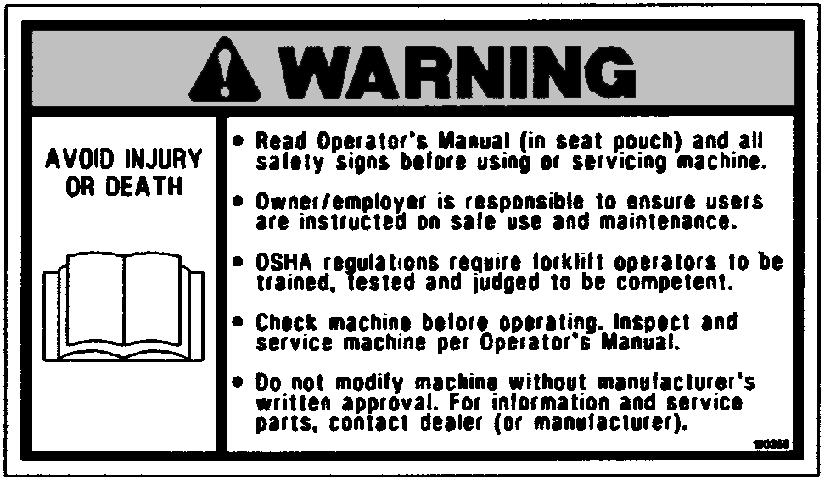
808033
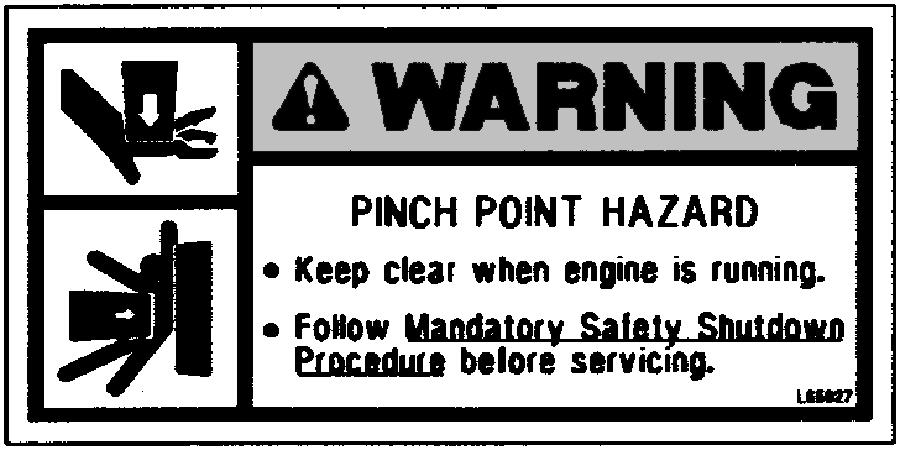
808034 51200535
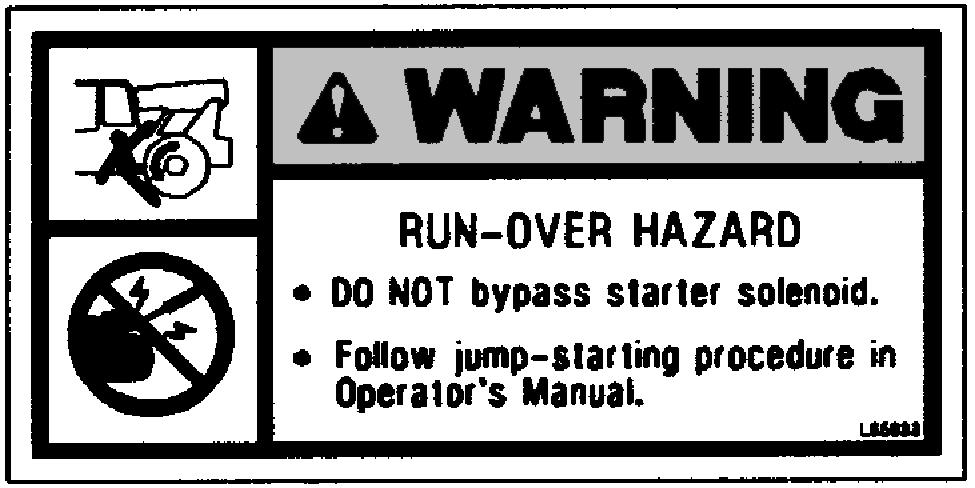
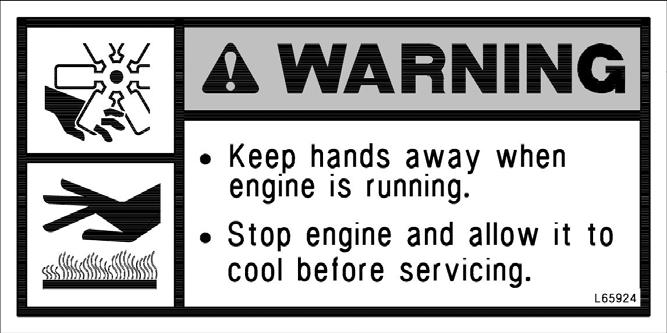
808036

808035

SAFETY
PWP Safety Decals
808042 808039 808040 808041
808039
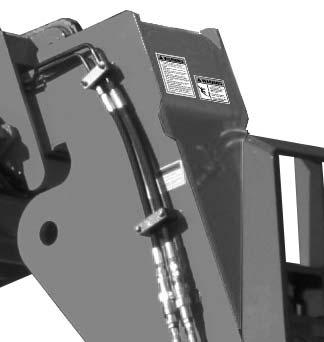
808041

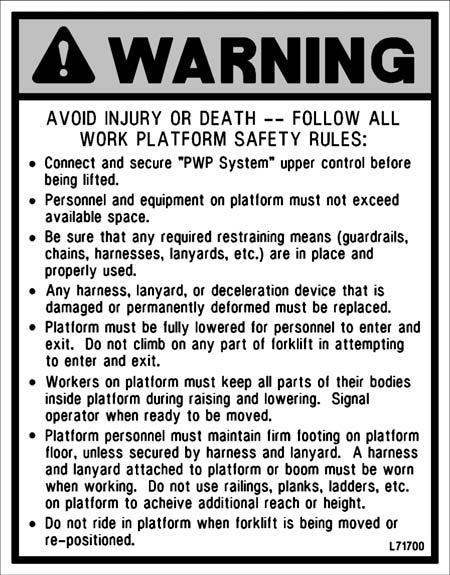
808040 808039
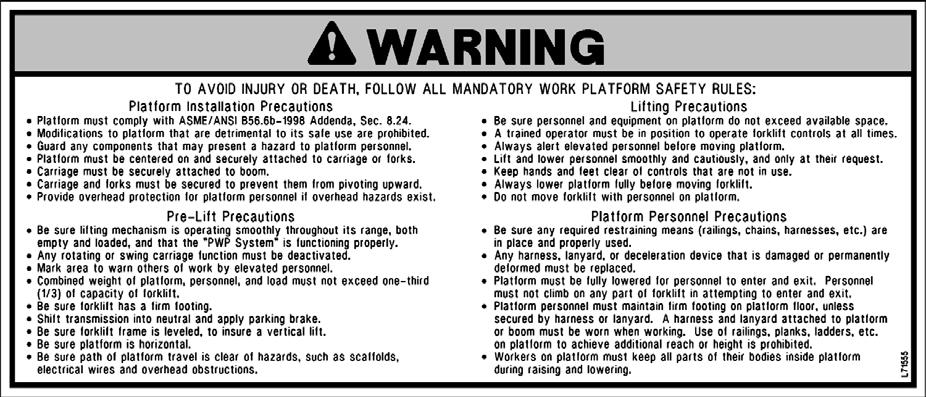
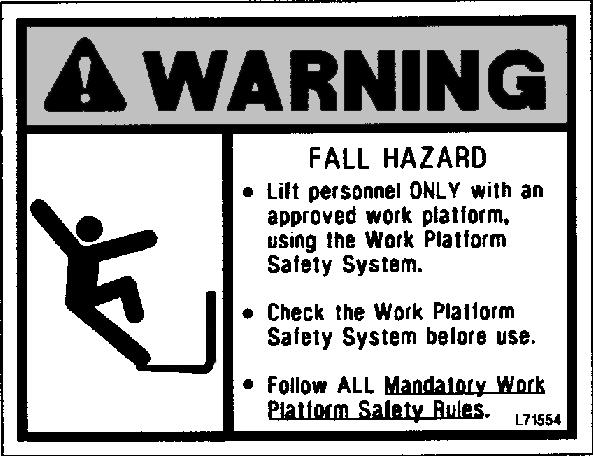
808042





